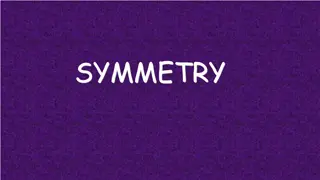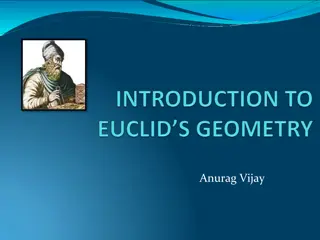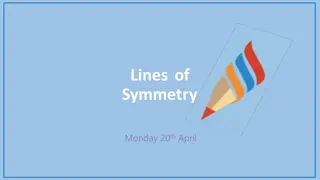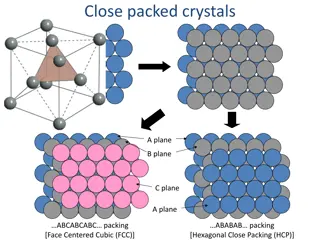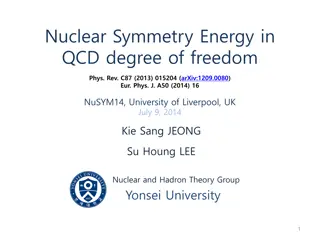Crystal Geometry Systems and Symmetry Elements
Crystal geometry involves the study of seven crystal systems defined by three symmetry elements - centre of symmetry, planes of symmetry, and axes of symmetry. These symmetry elements play crucial roles in determining the geometric properties of crystals. The centre of symmetry, plane of symmetry, and axis of symmetry each contribute to the overall symmetry exhibited by crystals. Understanding these elements is essential in crystallography and materials science.
Download Presentation

Please find below an Image/Link to download the presentation.
The content on the website is provided AS IS for your information and personal use only. It may not be sold, licensed, or shared on other websites without obtaining consent from the author.If you encounter any issues during the download, it is possible that the publisher has removed the file from their server.
You are allowed to download the files provided on this website for personal or commercial use, subject to the condition that they are used lawfully. All files are the property of their respective owners.
The content on the website is provided AS IS for your information and personal use only. It may not be sold, licensed, or shared on other websites without obtaining consent from the author.
E N D
Presentation Transcript
THIRD YEAR T.D.C., SCIENCE THIRD YEAR T.D.C., SCIENCE PAPER PAPER- -III, Part D III, Part D Paper Code Paper Code - - 3163
UNIT 1 : CRYSTAL GEOMETRY The seven crystal systems are characterized by three symmetry elements namely : Symmetry Elements: CRYSTAL SYMMETRY 1. Centre of symmetry 2. Planes of symmetry 3. Axes of symmetry. I. It is a point such that any line drawn through it will meet the surface of the crystal at equal distances on either side. Since centre lies at equal distances from various symmetrical positions it is also known as `centre of inversions . CENTRE OF SYMMETRY It is equivalent to reflection through a point. 2
UNIT 1 : CRYSTAL GEOMETRY Symmetry Elements: CRYSTAL SYMMETRY The seven crystal systems are characterized by three symmetry elements namely : I. CENTRE OF SYMMETRY Some objects have special symmetry about an origin such that, for any point at position x, y, z, there is an exactly similar point at x, y, z. The origin is called a centre of symmetry or inversion centre . Such an object is said to be centrosymmetric For example, for a unit cell of cubic lattice, the point at the body centre represents the `centre of symmetry as shown in the figure. A Crystal may possess a number of planes or axes of symmetry but it can have only one centre of symmetry. 3
UNIT 1 : CRYSTAL GEOMETRY Symmetry Elements: CRYSTAL SYMMETRY Planes of Symmetry Parallel to the Faces of a Cube Planes of Symmetry Parallel to the Faces of a Cube II. PLANE OF SYMMETRY A crystal is said to have a plane of symmetry, when it is divided by an imaginary plane into two halves, such that one is the mirror image of the other. For example, in the case of a cube, there are Diagonal Planes of Symmetry Diagonal Planes of Symmetry Three planes of symmetry parallel to the faces of the cube and Six diagonal planes of symmetry 4
UNIT 1 : CRYSTAL GEOMETRY Symmetry Elements: CRYSTAL SYMMETRY III. AXIS OF SYMMETRY It is an axis passing through the crystal such that if the crystal is rotated around it through some angle, the crystal remains invariant. The axis is called `n-fold, axis if the angle of rotation if the angle of rotation is 3600/n. If equivalent configuration occurs after rotation of 180 , 120 and 90 , the axes of rotation are known as two-fold, three-fold and four-fold axes respectively. A pictorial depiction of n -fold axis of symmetry for 2 dimensions of symmetry 5
UNIT 1 : CRYSTAL GEOMETRY Symmetry Elements: CRYSTAL SYMMETRY III. AXIS OF SYMMETRY If a cube is rotated through 90 , about an axis normal to one of its faces at its mid point, it brings the cube into the same position. Hence during one complete rotation (360 ) about this axisthe cube is coincident with its original position at four positions. A figure having only identity axes of rotation. For any axis that is chosen, the figure has to be rotated by 3600 for self coincidence (i.e., for the figure to look the same) Thus this axis has four-fold axes of symmetry or is called a tetrad axis If n=1, the crystal has to be rotated through an angle = 360 , about an axis to achieve self coincidence. Such an axis is called an `identity axis . Each crystal possesses an infinite number of identity axes. 6
UNIT 1 : CRYSTAL GEOMETRY Symmetry Elements: CRYSTAL SYMMETRY III. AXIS OF SYMMETRY If n=2, the crystal has to be rotated through an angle = 180 about an axis to achieve self coincidence. Such an axis is called a `diad axis . Since there are 12 such edges in a cube, the number of diad axes is six. If n=3, the crystal has to be rotated through an angle = 120 about an axis to achieve self coincidence. Such an axis is called is `triad axis . In a cube, the axis passing through a solid diagonal acts as a triad axis. 7
UNIT 1 : CRYSTAL GEOMETRY Symmetry Elements: CRYSTAL SYMMETRY III. AXIS OF SYMMETRY Since there are 4 solid diagonals in a cube, the number of triad axis is four. If n=6, the corresponding angle of rotation is 60 and the axis of rotation is called a hexad axis. A cubic crystal does not possess any hexad axis. Crystalline solids do not show 5-fold axis of symmetry No symmetry axis higher than `six is possible. In the above figures we can see that on trying to arrange shapes with 5 fold axis or 8 fold axis, gaps are created and so it is not possible Identical repetition of an unit can take place only when we consider 1,2,3,4 and 6 fold axes. 8
UNIT 1 : CRYSTAL GEOMETRY Symmetry Elements: CRYSTAL SYMMETRY IV. ROTO INVERSION AXES Rotation inversion axis is a symmetry element which has a compound operation of a proper rotation and an inversion [(x, y, z) (-x, -y, -z)] A crystal structure is said to possess a rotation inversion axis if it is brought into self coincidence by rotation followed by an inversion about a lattice point through which the rotation axis passes. 9
UNIT 1 : CRYSTAL GEOMETRY Symmetry Elements: CRYSTAL SYMMETRY IV. ROTO INVERSION AXES Consider an axis xx1, normal to the circle passing through the centre as given in the figure. Let a point (1) be rotated through 90o to come to the position (4). Point (3) has come to point (2) In the mean while, (2) to earlier (1) and (4) to earlier (3) Now if we follow this by inversion to the position (2), (2) will go to where (4) now is and (4) to where (2) was. This compound operation can then be repeated until the original position is again reached. 10
UNIT 1 : CRYSTAL GEOMETRY Symmetry Elements: CRYSTAL SYMMETRY V. Combination of symmetry elements: Point groups and space groups Apart from the different symmetry elements different combinations of the basic symmetry elements are also possible They give rise to different symmetry points in the crystal. The combination of symmetry elements at a point is called a `point group . 11
UNIT 1 : CRYSTAL GEOMETRY Symmetry Elements: CRYSTAL SYMMETRY V. Combination of symmetry elements: Point groups and space groups In crystals, 32 point groups are possible. The combination of 32 point groups with 14 Bravais lattices lead to 230 unique arrangements of points in space. They are called as `space groups . 12







